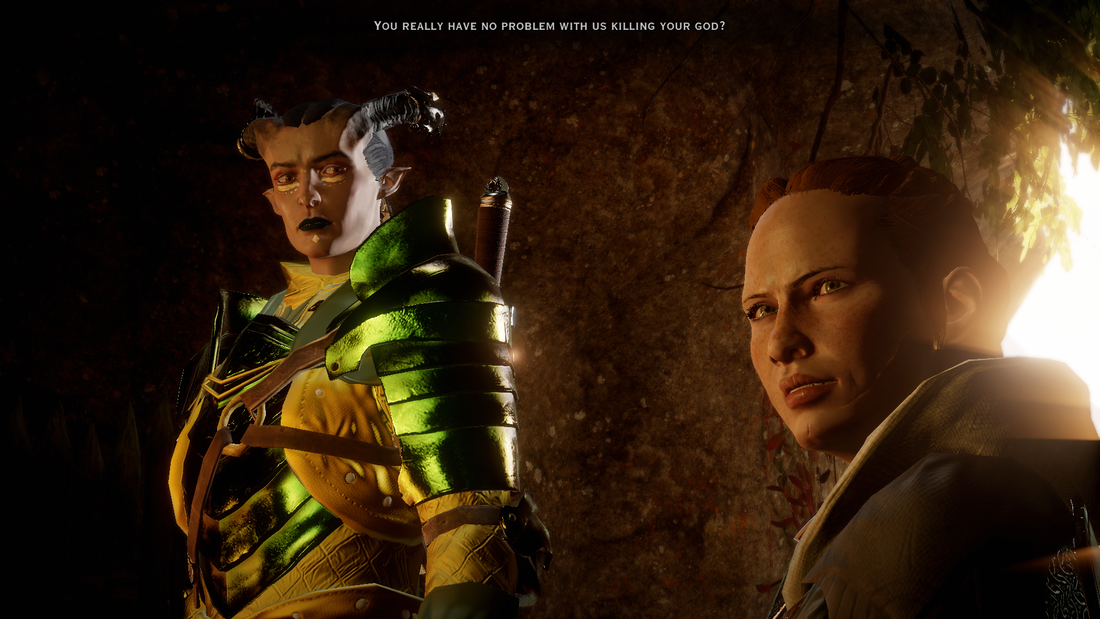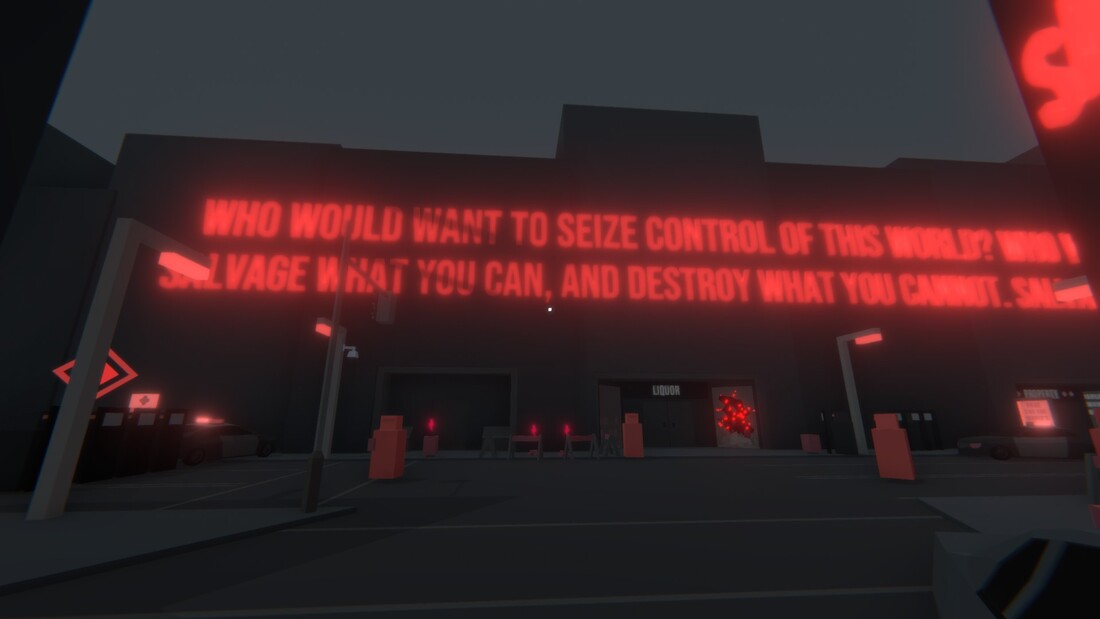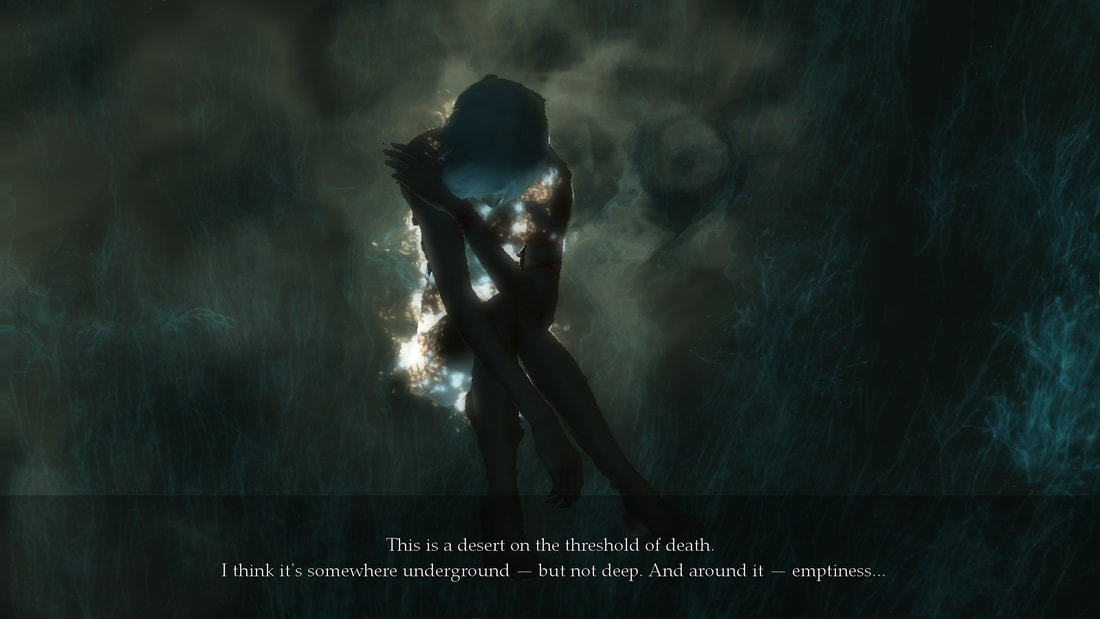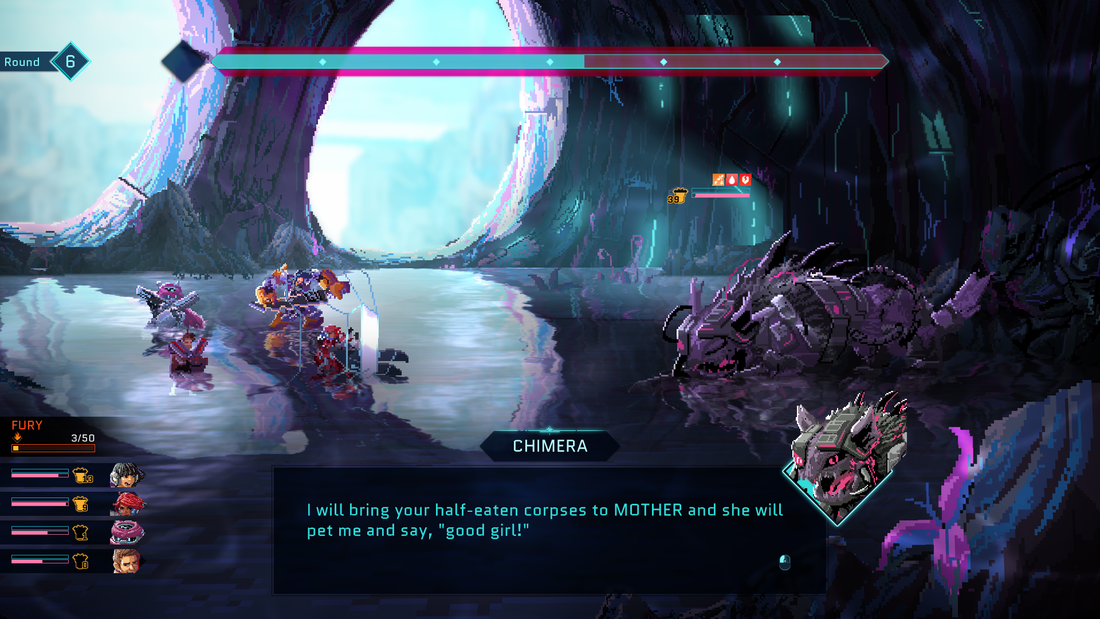|
by Luv Mehta We’re at the fourth consecutive article in this series - if you’ve kept up so far, thank you! And if you haven’t, I really recommend you check the previous articles out. You might find something to your liking. Just in case, though, a quick refresher - I’m recording the new (and old) stuff I’m watching, playing or listening to, and I’m doing it in a series of monthly articles. I’ll write some quick notes about the old stuff I went back to in the first section (Repeat Value), before getting into the new stuff (...The New Stuff). Repeat ValueDragon Age InquisitionI touched on it briefly last month because I had started it back then, but Dragon Age Inquisition is one of my favourite games of all time. Funnily enough, though, I’ve never completed all of it - DA:I is a game notorious for having huge maps with very little in terms of story quests, and tackling all of it requires at least 60 hours of play, which is in addition to the three pieces of additional downloadable content the game got after release. The three pieces of DLC are very different, and are modeled towards different archetypes of RPGs, with one being set in a huge map with lots of landmarks and quests, one being a dungeon delving adventure, and one being a linear story-heavy piece of content. Of the three, I avoided the first for a very long while. Then, during the latest playthrough, I decided to get into the very particular mindset the game needs to be fully enjoyed, and finally tackled the sole DLC left - Jaws of Hakkon. No spoilers for those who haven’t played the game yet, but it’s interesting how the world of Dragon Age’s setting, Thedas, seems full of infinite possibilities despite being limited to a single continent. A huge part of it is because the lore we learn regarding the world is always subjective - we never learn about the history of the elves, for example, we only learn about elven history told from different perspectives. Even the codex entries in the series have reflected that, with most of them not being descriptive and encyclopedic, like Mass Effect, instead conveying information through explicit in-universe history book extracts, letters, poems and folk tales. So when we’re told that something we knew about elven history was false all along, instead of thinking of it as a cheap twist, we feel amazed and enlightened, because each discovery uncovers something new about the culture of the world, as well as the biases of the people that sought to hide that information. This is similarly seen in Jaws Of Hakkon, which reveals a bunch of lore regarding the first Inquisitor, a figure shrouded in myth, legend, and political revisionism. The reveals feel even more impactful to your protagonist, the leader of the second Inquisition - the game’s treatment of your character as being near-mythical to the world is a constant theme in the story, and characters often bring up the fact that, despite what you think about yourself, history will deify you and change the story of your deeds as it sees fit. And as you explore and learn more about your predecessor, you realize just how much the same was done to his story. It’s a great piece of DLC, and even though this game (and the next) ate into most of the free time I get, I’m happy I’m finally up to date with everything in the Dragon Age games. Pillars Of Eternity: DeadfireWhile Mass Effect and Dragon Age are by BioWare, which have historically been my favourite game studio, Obsidian is another studio that’s a close second. They’re both studios that mostly only focus on RPGs, with the latter having been born out of making acclaimed sequels to two of the former’s games, and still being most popular for their spin-off title to Bethesda’s Fallout 3, Fallout: New Vegas. Outside of those aforementioned BioWare games, Obsidian’s Pillars Of Eternity games have been the RPG series I’ve spent the most time in. The series is sort of an underdog at present, with the first game setting records in its attempt to revitalize classical isometric cRPGs, but the second falling short of sales expectations and being all but shelved (though a new Elder Scrolls-like game in its universe has been announced by Obsidian recently). The most interesting thing about the Pillars setting, Eora, which started off as a spiritual successor to D&D’s Forgotten Realms setting before adding so many tweaks that it became a wholly different beast in its own right, is that it makes the existence of souls, reincarnation and gods explicitly and tangibly real. Firstly, people can, in incredibly rare cases, awaken to the full memories of their past lives, which is implied as being extremely traumatic and almost assuredly driving them insane - and your protagonist starts off having gone through the same ordeal too. Secondly, souls themselves can be stored and even used as fuel in prototype machinery, which itself is a new and feared development in the history of the setting. Lastly, the gods themselves often interfere in mortal matters, with the first game having been preceded by a holy war led by an incarnation of one of them. Playing Dragon Age again recently has made me compare the way the two settings choose to reveal their histories. While Dragon Age delights in teasing out incomplete and subjective snatches of history, Pillars Of Eternity usually resolves its mysteries with clear, unambiguous answers, with the first having a great ending that unfortunately clears most of the questions you might have had about the ancient forerunner species in that setting, as well as about the gods. Pillars Of Eternity: Deadfire, the sequel, has to deal with a lingering lack of mystique, so it smartly uses the majority of its sidequests (which are what you engage with for nearly all of your playtime) to focus on the different factions you meet in the seas, and the clash of culture and economy both between and within them. However, the main story still focuses on a conflict within the gods, where you’re sent on behalf of most of them to pursue the remaining god that seems to have strange plans for all the people of Eora - and with no mysteries remaining, most of it is spent witnessing the squabbles between these divine beings who feel completely mundane. Like with DA:I, I’ve put a lot of hours into PoE2, but I’ve never completed all the DLC in the game. Unlike DA:I, PoE2 is huge and stuffed with content, with each combat encounter requiring strategy and planning. I wasn’t in the mood to play through 80 hours of tough, engaging combat, so I decided to forgo the hardest difficulty and settle for Hard, which is pretty easy if you know what you’re doing and spend enough time levelling up. I’ve already worn myself out with 46 hours spent so far, though, and I’m at max level and still in the middle of the second DLC. I’ll need some time before I can come back to complete it. The New StuffA short note - I’ve been told by a reader that they felt uncomfortable with the amount of anticapitalist games I used to play and highlight in this series of articles. While a lot of indie games do end up explicitly engaging in such themes, I realize that such stuff can make people feel excluded, and hope they don’t find the stuff I mention here, going forward, as being politically divisive and contentious. Anyway, on to the new stuff I played this month! I didn’t really watch or listen to anything new, so it’s all games this month. 5. They Came From A Communist PlanetThe first in a pair of explicitly anticapitalist games from an indie developer, Colestia, this is a fairly simple and short game that you can finish in half an hour. The number of people working on this game is immensely small, so there’s some basic 3D models and incidental gameplay mechanics. You start the game as a nameless protagonist trapped in a small flat, unable to pay rent or find jobs, with your walls leaking during the rain. Eventually, a UFO comes down from the skies and shines its red tractor beam on you, with an important message - you’re hopeless and have no future because the system sustains itself by keeping most people in your state. Your only means of escaping the system is to tear it down, but throw the first brick and you’ll always have people joining in, because you’re not alone. The nature of the game is didactic - you’re put on the streets and given helpful instructions on how to start a riot, throw bricks, ignite molotov cocktails, etc, but the aliens never do anything beyond giving you advice. Their main goal seems to involve giving the tools of revolution to the masses in planets “burdened” by capitalism. There’s sort of a trend in games and other media recently, where the creators are afraid to label something they make as explicitly political, to appeal to the most number of people and avoid angering fringe groups that will take to harassing them online. It’s refreshing, then, to play games that have an unapologetically strong point of view, once in a while, and indie games always scratch that itch very well. This is the first of the two free games from Colestia I played this month, with the second being... 4. A Bewitching RevolutionThis is a little more in-depth than the last game, owing to its premise. It’s still meant to be completed in a half-hour sitting, but it’s free, so there’s honestly no reason not to try it out. It’s also much more preachy than the last one, so your mileage will vary, but if you’re fine with that, go ahead! Your player character is a witch that answers prayers to help people in a run-down town, giving them tarot card readings that always turn out to be an indictment of the oppressive system they’re living under. Your advice changes the world around you - fast-food outlets become community kitchens, job consultants become learning centres, and so on. Eventually, law enforcement cracks down, and you witness your influence result in a full-blown riot. The music in this game is great too, dynamically going through a mix of harmonies and varying in tempo as the things you do change the town around you, and as it reacts to you. All-in-all, it’s a great package that’s worth playing in a single sitting. 3. The VoidMade by the studio behind my favourite game of last month (and which will probably be at least in the top 3 for my year), The Void is a game by Ice-Pick Lodge that’s difficult, abstract, surreal and hard to describe - and I really hope people try it out. The setting sounds like an acid-induced dream - you are the soul of a human being that has died after a long period of starvation, and you now find yourself in a strange purgatory called the Void, filled with mystical women called Sisters and eldritch monstrosities called Brothers. You’re given the responsibility to save the Void by filling it with colour, but each Sister and Brother has their own idea of your role in the story, and you find their conflicts complicating matters substantially. Like Ice-Pick Lodge’s other games, you also have to take care of your own survival while helping the world. You’re essentially a filtration machine that takes colour from the Void, feeds it through their own hearts, and takes the processed colour and puts it back into the Void. You need to keep your hearts filled, though, or you’ll die if it runs out of colour while processing it. It’s a strange concept to wrap your head around, and proper planning is always required so you have enough colour to sustain yourself and help others, but it’s easy to get the hang of it. If you’re interested, do check out some gameplay videos and see if it’ll be your cup of tea. 2. Hypnospace OutlawHypnospace Outlaw is a fun little detective game with a neat interface for gameplay - but let me explain the setting first. In the alternate history of this game’s setting, in 1999, a few companies invented a way for people to use computers in their sleep by using special headsets, which let them be productive and have fun 24/7. One of them, Hypnospace, meant for casual audiences ranging from teens to seniors, has its own dedicated subscription-based internet, and users can log on to different parts of the NET and make their own blogs. With an online community comes a need for online policing for various serious offences, ranging from bullying to content infringement, and you play a volunteer Hypnospace enforcer that must go through all those blogs to enforce those community rules. What follows is a great, charming little game that’s a detective yarn (you investigate various offences and look for clues to lead you to offences) as well as a loving parody, making good-natured fun of the creativity and excesses of the early Internet, with scrolling text, stylized but barely legible titles, and an abundance of personality. As you go through the game, you find a nice, touching story with well-written fully realized characters bursting with personalities, even if (or especially because) you basically see their unbridled creativity burst through these pages. All in all, it’s a great 10-hour experience I highly recommend. 1. Star RenegadesLike Slay The Spire last month, Star Renegades is a neat roguelike with a nice twist. While not as infinitely replayable as StS, it does have its own gameplay quirks and charm, which I’ll get into. Firstly, just a refresher - roguelike games generally have strong gameplay loops and semi-randomized enemies and levels. Most roguelikes usually give you a bunch of options to customize your playstyle, along with a set of obstacles to test them against, and you’re encouraged to start new playthroughs and experiment with those options. Star Renegades has a neat setting to contextualize this - a galactic empire is under attack by a technologically advanced alien force that can hop across different parallel universes, and are hell-bent on destroying all versions of them one-by-one. After a brief tutorial, you control a droid as it escapes a universe already facing destruction, and take its knowledge into the next - and you’ll be doing this multiple times after failed runs, taking your accumulated using it to find better equipment, upgrade the new versions of the varied types of military characters you find, and push ahead to eventually win and destroy them. Speaking of the characters, you get a bunch of varied archetypes with nice personalities and useful combat abilities, and the battles take place in a turn-based arena that shows the timing and plans of each of the enemy units. This helps you strategize with your characters and use their abilities in synergy, which you’ll have to learn to avoid a bloodbath, especially in later levels. It’s not perfect, though. Each new run gives you four locations to defend, and each location takes up to an hour to complete - which effectively means that each new run ends up taking too long, and if you’ve gained enough expertise to breeze through the early locations, you’re going to end up feeling like you’re repeating yourself and going through the motions quite a bit. Even so, I’ve spent plenty of time with this one, and it’s definitely worth playing. And that’s it for this month! Have a great October, and check back next month for more!
Follow us on Facebook and Instagram to be notified whenever we release new articles.
Do you use an RSS reader? Even better!
0 Comments
Your comment will be posted after it is approved.
Leave a Reply. |
Categories
All
Archives
December 2022
|







 RSS Feed
RSS Feed
